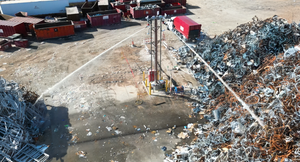Canadian Partners Push Housing Relocation Over Demolition

Canada has been called the demolition capital of the world, with thousands of homes knocked down every year while the country faces an acute housing shortage. Yet about 20 to 40% of those homes could be relocated, shrinking emissions from building, tearing down, and landfilling them, while filling a widening demand and supply gap.
Light House, a nonprofit that shapes policy to “green” Canada’s built industry, is working with partners to push home relocation over demolition, at least in British Columbia. But its new model could work just about anywhere, says Gil Yaron, managing director at Light House. Already a few U.S. municipalities are prioritizing similar circularity approaches as their population grows denser; housing stock thins; and their landfills fill with construction and demolition waste.
In British Columbia, house mover Nickel Bros loads homes on barges that haul them to their new destinations. By the time they’re ocean bound they will have had a facelift at a previous stop: a housing repurposing facility where the structures are raised on blocks and upgraded, mostly for energy efficiency, but also for minor cosmetic upgrades.
“Our repurposing facility is one way we are creating efficiencies and economies of scale in this [relocation] model. Our goal is to get homes modernized and then out to islands or coastal communities as fast as we can,” says Glyn Lewis, owner of Renewal Home Development, who does the upgrades.
Doing the work at the Vancouver metro area facility is faster and cheaper than upgrading the structures at the remote properties of the soon-to-be new homeowners.
A building is first assessed for its condition. Does it have “good bones” – solid walls and flooring and overall sound structure? Step two is to determine if the structure can be moved and how complicated it would be to transport it.
Every city has different complexities around typography and geography. Is the land flat? Are roads wide enough to accommodate these gargantuan loads? Are there many overhead utility lines, and can trucks easily clear them?
While environmental outcomes of relocation will be project specific, studies show about 65 metric tons of carbon associated with building a new home are avoided, on top of another 65 metric tons otherwise generated from demolishing and landfilling the home.
Yaron’s partner, Nickel Bros, has relocated homes for years, though not exactly at scale due to policy barriers.
“Unfortunately, due to the fatigue of fighting government regulations, some companies have abandoned house relocation as a service. We need all levels of government to help create further incentives and standards for the responsible and sustainable repurposing of homes,” says Jeremy Nickel, president of Nickel Bros House Moving.
“We also need developers, realtors, and homeowners to learn about, and consider relocation instead of defaulting to demolition,” he says.
Light House is looking for buy in and working to finetune the model to work for all potential players. Yaron is beginning to engage with First Nations [tribal communities] in need of housing, as well as talking to social housing organizations.
A pilot launched, July 2023, is taking the new housing relocation and repurposing model for a test drive. Lewis is in the midst of upgrading five donated homes that once stood in Coquitlam, British Columbia.
A life cycle analysis is yet to be done, but Light House and partners estimate moving and repurposing these homes will save up to 397 tons of embodied carbon. Plans are to build 49 townhomes on the newly cleared Coquitlam lots.
It hasn’t been too hard to show that shifting to this alternative approach can make economic sense. Relocating a home costs about $100 to $125 per square foot, while building a new one can run $450 a square foot or more, depending on location.
Through Canada’s charitable tax law, developers or homeowners can now donate houses to tribal communities and get tax credits.
“So, what used to be a liability is now of value. It would normally cost between $20,000 and $40,000 to abate, demolish, and landfill a home. This model encourages developers to donate what they would have otherwise spent to the First Nation to offset the costs associated with moving and repurposing the home,” Yaron says.
On the federal level, grants traditionally available to build or renovate structures will now be able to help fund relocation.
Light House is working on other policy mechanisms that prioritize home relocation over demolition, calling for expedited special permitting as well as required assessments of homes slated for demolition. They’d have to be relocated when determined feasible, and deconstructed when they can’t be moved intact, with the materials salvaged and reused or recycled.
Most greenhouse gas emissions over a home’s life, about 70%, are from embodied carbon—what went into building the home— the materials, cutting down trees, extracting copper to build pipes …
“We mitigate that 70% by not just throwing the building away,” Lewis says.
But then there’s the other 30% of emissions. That’s where the work he and his team do at the repurposing facility comes in. It typically entails upgrading insulation, windows, and appliances; converting to heat pump systems; and or other power-saving improvements.
But emissions come from materials too– concrete for example is a huge emitter; one pound of it generates nearly the same weight in carbon. Lewis found a product with about 80% less emissions than conventional concrete.
So, in addition to prioritizing energy efficiency, learning these details has been important as he vets materials, he says.
=As these Canadian-based partners work to salvage buildings, ultimately advancing circularity, there’s a trend driving a demolition windfall and resulting waste. That trend is to densify, particularly in urban areas, where some developers are buying tens of thousands of single-family homes and replacing them with townhouses, condos, and apartments.
“So, the policy conversation now is, how do we mitigate all that material waste? How do we create incentives for developers and homeowners who are going to remove these buildings to do it as responsibly as possible? Relocate if you can. Deconstruct if you can’t,” Lewis says.
About the Author
You May Also Like




.png?width=300&auto=webp&quality=80&disable=upscale)